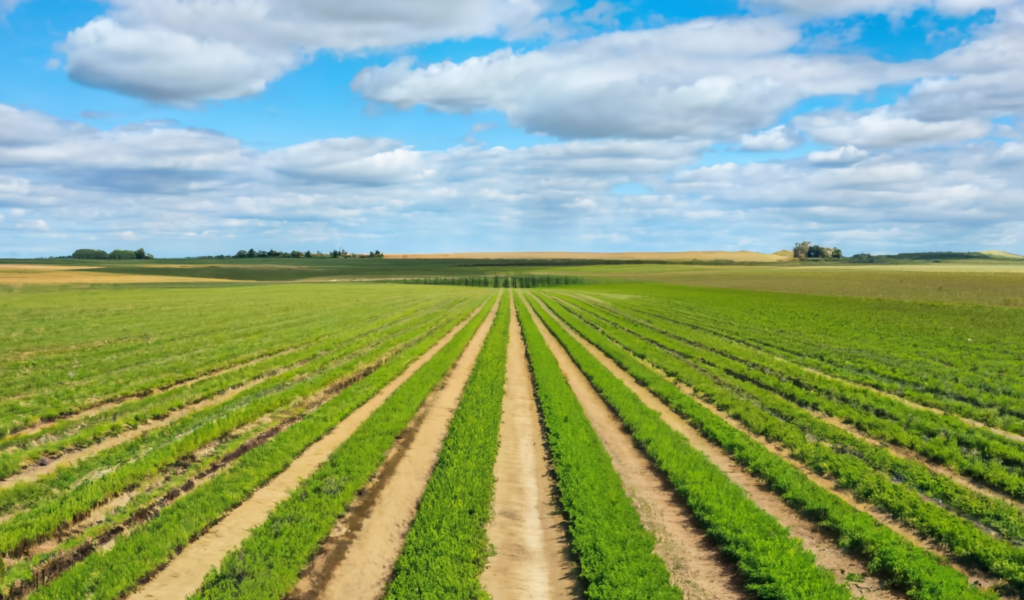
Investing in Farmland
admin - March 12, 2024Farmland has gained popularity as an alternative investment class that can offer a hedge against inflation, generate income, and provide capital appreciation over time. Unlike traditional stocks and bonds, a farmland investment is tied to the tangible asset of agricultural land, which has intrinsic value due to its productive capacity.
In this article, we will take a look at some key aspects of investing in farmland.
Why invest in farmland?
Diversification: Farmland investments can diversify an investment portfolio, reducing risk. The performance of farmland can be uncorrelated with traditional financial markets, meaning it can provide stability even during economic downturns or volatile periods.
Inflation hedge: Historically, farmland values and rental incomes have kept pace with or exceeded inflation rates, making it an effective hedge against inflation.
Steady income: Farmland can generate a steady income through crop production, livestock grazing, leasing to farmers, or government subsidies. The return on investment typically comes from both the operational income of the farm and the appreciation of the land’s value over time.
Growing demand: With the global population projected to increase, the demand for food and agricultural products is expected to rise, potentially leading to increased value of productive farmland. In 2023, the United Nation predicted that the world will need 60% more food by 2050 to cope with population growth. In recent years, supply chain issues have also brought an increased realization to many that imported food might not always be available in sufficient amounts, making the availability of locally and regionally produced food more important.
How to invest in farmland
Direct ownership: The most straightforward way to invest in farmland is through direct ownership, where an investor purchases agricultural land. This method requires significant capital and knowledge of agricultural operations and land management. You can invest in your own name or create a business entity that carries out the purchase and retains ownership.
Farmland REITs (Real Estate Investment Trusts): REITs that specialize in farmland offer a more accessible way to invest. These trusts pool investor money to purchase and manage agricultural properties. Investors can buy shares in a farmland REIT, providing exposure to farmland investments without the need for direct management.
Farmland Investment Funds: Similar to REITs, these funds pool capital from investors to purchase and manage farmland. However, they may offer more diverse investment structures and strategies. Investment minimums can vary widely, and some funds may be limited to accredited investors.
Crowdfunding platforms: Crowdfunding platforms allow individuals to invest smaller amounts of capital in specific farming projects or pooled farmland investments. These platforms offer lower entry points and simplify the investment process.
Partnerships and joint ventures: Investors can enter into partnerships or joint ventures with existing farmers or agricultural businesses. This method allows for shared investment costs and operational responsibilities. Sometimes, this will not involve actually investing in farmland – you will only invest in a farming operation which is something very different.
Considerations and risks
Liquidity: Farmland is a relatively illiquid asset compared to stocks or bonds, meaning it can take longer to sell without impacting the price.
Market and weather risks: Agricultural production and land values can be affected by market fluctuations, weather events, and climate change.
Management and operational knowledge: Successful farmland investment often requires knowledge of agricultural practices, land management, and local market conditions. Investors opting for direct ownership or partnerships need to be prepared to either manage the farm themselves or hire experienced operators.
Regulatory issues and environmental issues: Potential investors should be aware of regulatory and environmental considerations, including land use regulations, water rights, and sustainable farming practices.
High maintenance costs: Owning land outright can come with high and unpredictable maintenance costs and legal liabilities. This is one of the reasons why many investors prefer to go through a fund instead of owning land in their own name.
Recent trends
As of 2024, we can see a clear multi-year trend of investment funds stocking up on farmland, which is percieved as a safe-haven investment in times of inflation and instability. The trend is especially noticable in the United Strates, where many major mutual funds are based. Examples of funds known to invest heavily in U.S. Farmland right now are Manulife Investment Management and Nuveen.
Already, there is some concern in the U.S. that this might make farmland less affordable for the next generation of farmers, who might have to settle for land-lease agreements and simlar instead of being able to buy farms. In 2023, the average price of an acre of cropland reached a record-breaking $5,460. (In 2010, it was around $2,700.) Today, roughly 60% of the U.S. farmland is owned by people who also operate the farm. The remaining 40% is owned by non-farmers, such as corporations, trusts and non-farming individuals.
In the United States, the number of properties owned by mutual funds and similar investors increased by over 230% between 2008 and the second quarter of 2023.
Another aspect of the boom in farmland investing that have caused some consternation is foreign large-scale ownership of U.S. farmlands. In 2022, U.S. lawmakers debated the pros and cons of limiting foreign ownership of farmland, with China, Russia, Iran and North Korea considered especially likely to purchase U.S. farmland for political and military reasons. Between 2010 and 2021, the number of U.S. acres owned by foreign entities rose by almost 65%.
Conclusion
Investing in farmland presents a unique opportunity for portfolio diversification, income generation, and capital appreciation. However, like any investment, it comes with its own set of risks and considerations. Prospective investors should conduct thorough due diligence, consider their long-term investment goals, and, if necessary, consult with financial advisors or experts in agricultural investment to make informed decisions.
This article was last updated on: March 12, 2024
